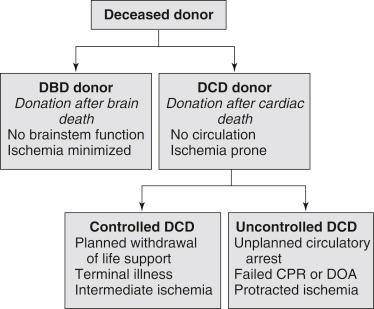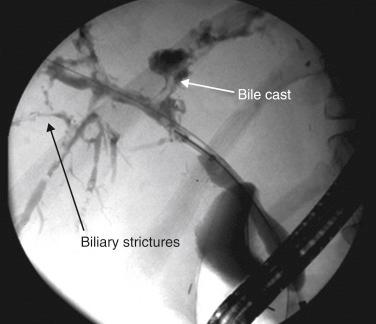Physical Address
304 North Cardinal St.
Dorchester Center, MA 02124
Donation after cardiac death (DCD), formerly referred to as non–heart-beating donation , has become the fastest-growing source of transplant organs in the United States over the past decade, bringing full circle the history of organ donation. This chapter reviews the history, ethics, practice guidelines, surgical techniques, clinical outcomes, and challenges of DCD liver transplantation, focusing on the controlled subgroup of DCDs. Profound disparity in supply and demand for transplantable livers causes tragic numbers of end-stage organ failure patients to succumb before receiving a transplant. Current mortality rates for patients on the United Network for Organ Sharing (UNOS) and Eurotransplant waiting lists are approximately 16% and 27%, respectively. In response, one method of increasing the donor pool is to use living donor livers, a high-stakes endeavor, and to use expanded criteria organs, including older, hepatitis C virus–positive, hepatitis B core antibody–positive, steatotic, injured, and reduced in size (split) livers. DCD is an additional type of expanded criteria donor, used in the United States, Europe, and Asia to boost the number of deceased donors and decrease the dire shortage of transplantable organs. The percent of deceased donors in the United States that are DCD has grown from 1% in 1996 to 13% in 2011; 5% of deceased donor liver transplants performed in 2011 were from DCD as were 16% of deceased donor kidney transplants, and DCDs have also provided for transplantation of pancreata and lungs.
DCD is characterized by irreversible unresponsiveness, apnea, and absence of circulation, in contrast to donation after brain death (DBD), defined by irreversible cessation of all brain functions. Organ ischemia is minimized in DBD because circulatory arrest typically occurs concurrently with perfusion of preservation solution and rapid core cooling. Thus the procurement procedure does not implicitly involve circulatory dysfunction. DCDs are less than ideal because the organs suffer ischemia during the prolonged periods between circulatory dysfunction, circulatory arrest, and subsequent perfusion and cooling. Furthermore, the surgical procedure for DCD organ recovery is demanding and rushed. It is important to differentiate controlled from uncontrolled DCDs ( Fig. 42-1 ).

Uncontrolled DCDs sustain circulatory arrest and either fail to respond to cardiopulmonary resuscitation or are declared dead on arrival at the hospital. Uncontrolled DCD is unplanned, so the organs suffer protracted ischemia before recovery. Although kidneys tolerate a short period of the resultant warm ischemia, transplantation of extrarenal organs from uncontrolled DCDs carries a much greater risk.
Controlled DCDs provide organs that are exposed to significantly less ischemic damage than those of uncontrolled DCDs and in general offer superior posttransplantation function when compared with uncontrolled DCDs. Controlled DCDs undergo circulatory arrest following planned withdrawal of life support (ventilatory and circulatory support), most often in the operating room, with a donor surgical team readily available. Except in rare circumstances, the potential controlled DCD does not meet brain death criteria, but the donor has sustained a catastrophic brain injury or other illness such as end-stage musculoskeletal disease, pulmonary disease, or high spinal cord injury and has no expectation of meaningful survival as determined by the treating physician(s). The patient’s legal decision maker(s) request withdrawal of support, whether or not organ donation is to be pursued. Subsequently, informed consent for organ donation is obtained from them if the patient is otherwise medically suitable for donation. Controlled DCD offers the family and patient with a hopeless prognosis the opportunity to donate when criteria for brain death will not be met before cardiac death.
In the early 1990s, investigators from Maastricht in the Netherlands described four categories of DCD donors: (1) dead on arrival, (2) unsuccessful resuscitation, (3) awaiting cardiac arrest, and (4) cardiac arrest while brain dead. A DCD donor who is dead on arrival is brought to the emergency department after being declared dead in the field. A DCD donor who is unsuccessfully resuscitated undergoes a determination that lifesaving efforts are useless. A DCD donor who is awaiting cardiac arrest has extensive brain damage but does not meet the criteria for brain death, and controlled withdrawal of support is then arranged. Finally, the fourth category includes DCD donors in whom brain death has been diagnosed and who sustain premature and unexpected cardiac arrest before the beginning of the donor operation. All but the third category are considered uncontrolled DCD situations.
During the earliest years of kidney transplantation, organ donation amounted to removal of kidneys from patients whose hearts had stopped beating. The first human kidney, liver, and heart transplants, in 1958, 1963, and 1967, respectively, were performed using organs recovered from uncontrolled DCDs. Through the 1960s, determination of death required heartbeat cessation. However, World War II led to the birth of modern critical care, including the use of respirators and cardiopulmonary resuscitation. It became possible to reestablish or maintain cardiopulmonary function in severely ill patients, which led neurophysiologists of the 1950s to study irreversible coma. Subsequently, in 1968 the multidisciplinary Ad Hoc Committee of the Harvard Medical School to Examine the Definition of Brain Death issued a landmark report that included criteria for the determination of brain death (Harvard Neurologic Definition and Criteria for Death). In 1980 the Uniform Law Commissioners adopted the Uniform Determination of Death Act (UDDA). According to the UDDA, “an individual who has sustained either (1) irreversible cessation of circulatory and respiratory functions, or (2) irreversible cessation of all functions of the entire brain, including the brainstem, is dead.” The UDDA has been endorsed by the major American and European medical and legal professional associations, and all 50 states have enacted brain death legislation.
During the mid-1970s, the practice of recovering organs from DCD donors was essentially abandoned. Organs recovered from DBD donors are considered more desirable because they are protected from the effects of warm ischemic injury and are less prone to poor graft function. For the following 25 years, virtually all donation was from DBD or live donation.
DCD organ transplantation was reintroduced by the University of Pittsburgh transplantation program in 1992. The Pittsburgh program and the program in Madison, Wisconsin, were pivotal in initiating controlled DCD organ transplantation and were the first to describe results of controlled DCD kidney and liver transplantation, both in 1995. The experiences were small and provided survival rates inferior to those after DBD liver transplantation, but these pioneering teams’ reports were encouraging and provided the impetus to further develop the field of controlled DCD liver transplantation. In 2000 Reich et al published the first successful series of controlled DCD liver transplantation; at a mean follow-up of 18 months, patient and graft survival rates were 100%, and there were no instances of primary nonfunction, hepatic artery thrombosis, or ischemic cholangiopathy. Thereafter other reports of increasingly larger DCD experiences were published.
These early experiences with controlled DCD occurred concurrently with the public’s increasing reluctance to prolong futile treatment and artificial life support of terminally injured and ill patients and with increasing use of advance directives and health care proxies. In 1997 the Institute of Medicine (IOM) of the National Academy of Sciences published its first report on DCD. The IOM, commissioned by the Department of Health and Human Services, considered DCD to be an ethical way to address the organ shortage and sought to increase such donations through their follow-up reports of 2000 and 2006. Starting in 2003, the Department of Health and Human Services organized the Organ Donation Breakthrough Collaboratives, mandating increased DCD and leading to a surge in DCD kidney and liver transplants. DCD has also been endorsed by the American Society of Transplant Surgeons (ASTS), the Society of Critical Care Medicine, UNOS, the Joint Commission, and the Centers for Medicare and Medicaid Services. Early estimates were that DCD could increase the deceased donor pool in the United States by over 1000 donors per year. The number of DCD donors steadily increased from only 42 in 1993 to 846 in 2008.
In 2003, the University of Pennsylvania group was the first to report a higher risk for major biliary complications in DCD liver recipients and to caution that DCD biliary epithelium is particularly prone to ischemia-reperfusion injury. Thereafter, enthusiasm for DCD livers has been tempered by widespread experiences of ischemic cholangiopathy, inferior survival and higher cost after transplant. Ischemic cholangiopathy manifests as biliary strictures and bile cast syndrome, and tends to present within the first few months after transplantation ( Fig. 42-2 ). It may resolve with biliary drainage or require repeated long-term endoscopic or percutaneous manipulations. Ischemic cholangiopathy often leads to graft loss and retransplantation or death. Unease about DCD liver transplantation is amplified by regulators’ and payers’ increasing focus on clinical outcomes and cost-of-care. The volume of DCD liver transplants performed has plateaued since 2005. Further concern about DCD relates to the decreased yield of transplantable organs from DCDs, some of whom might advance to brain death if given time.

Become a Clinical Tree membership for Full access and enjoy Unlimited articles
If you are a member. Log in here